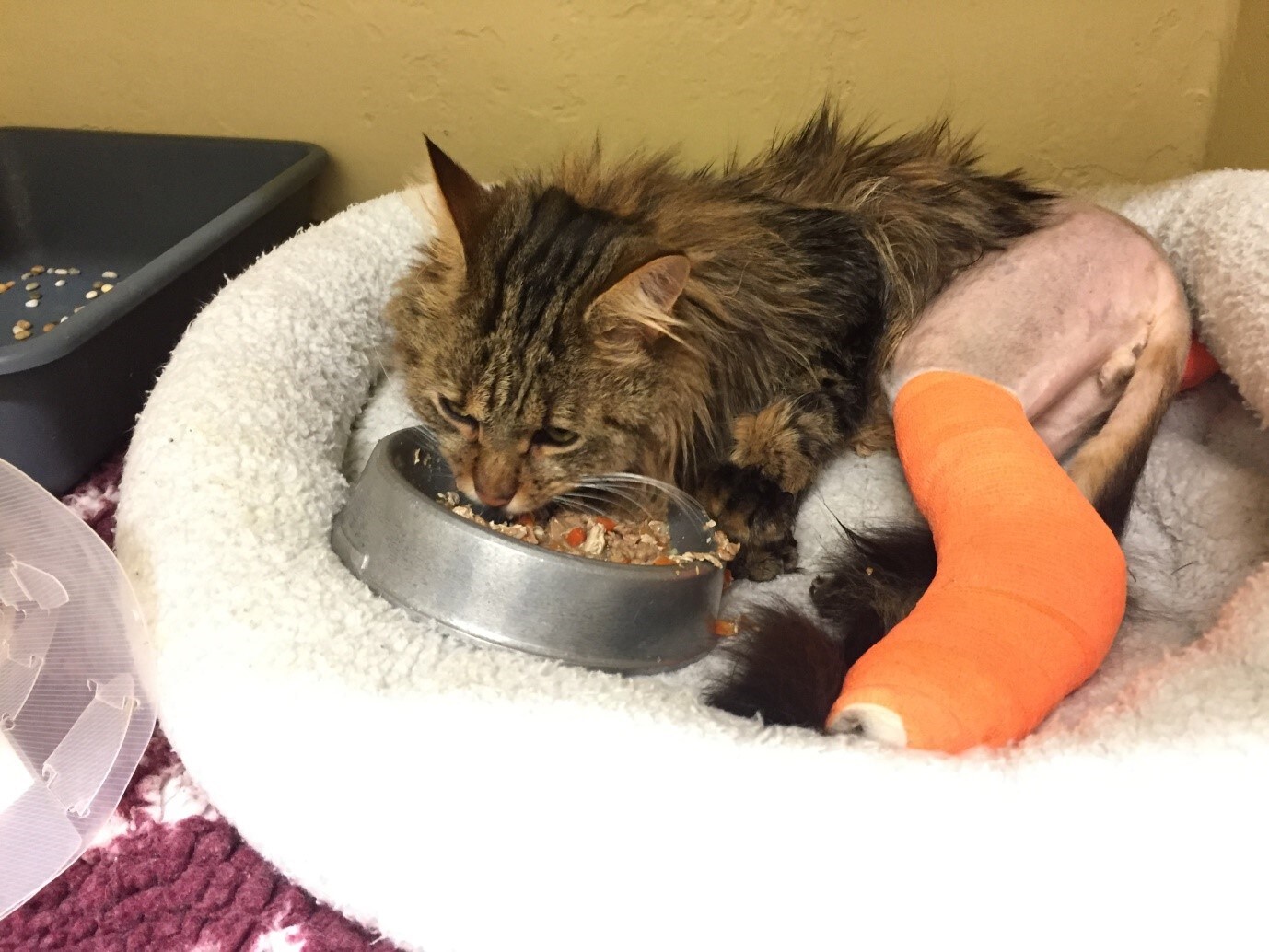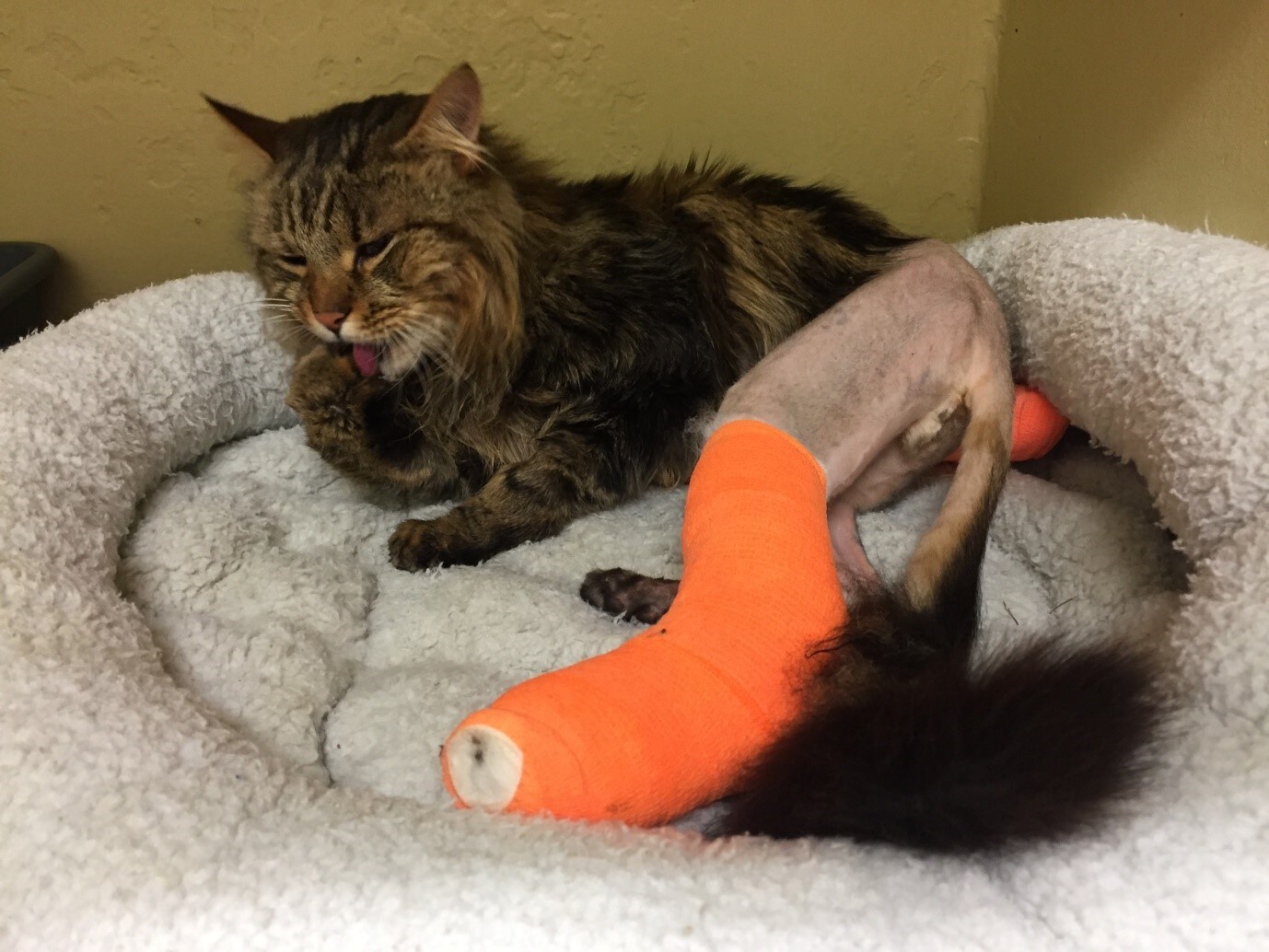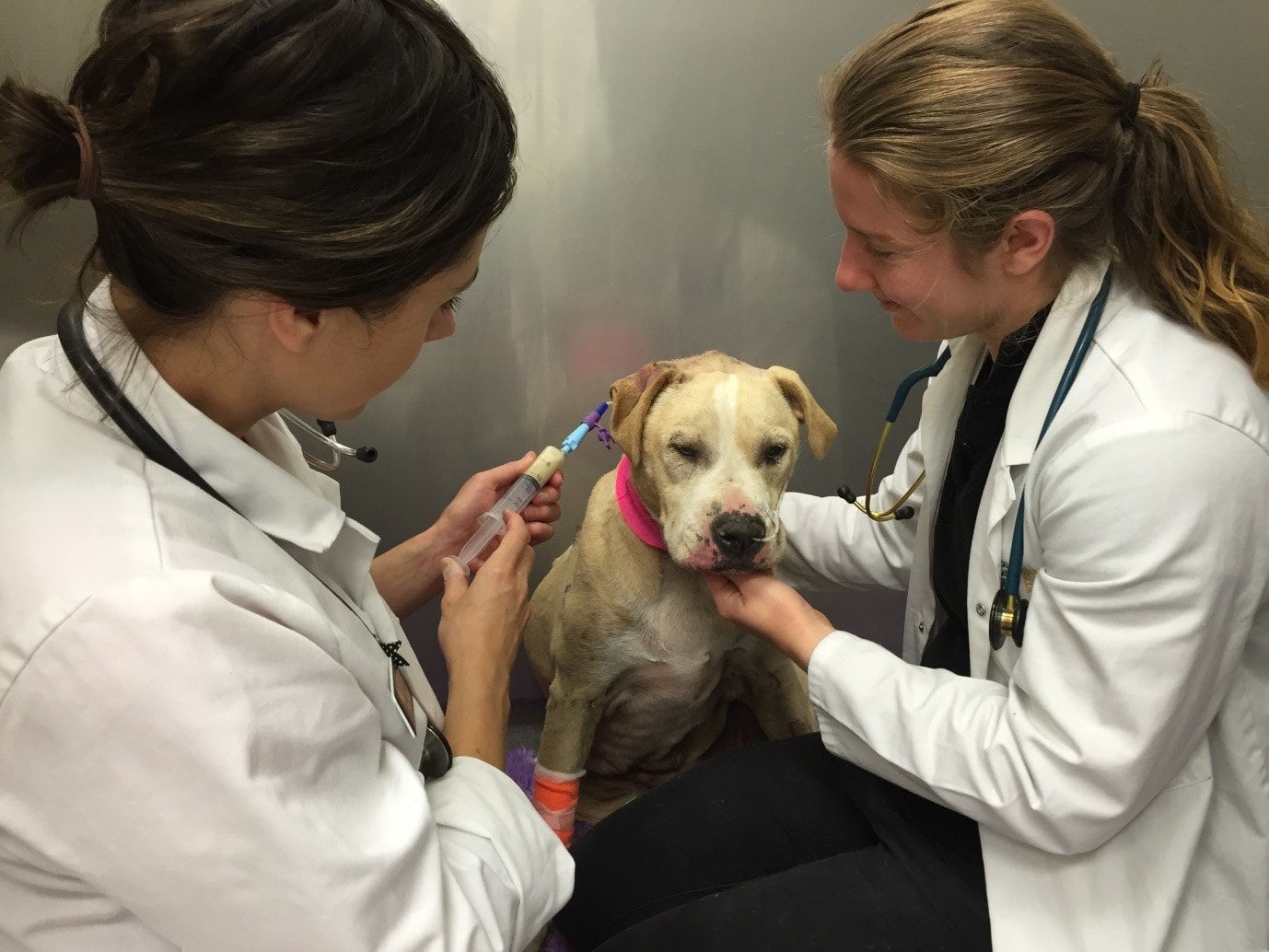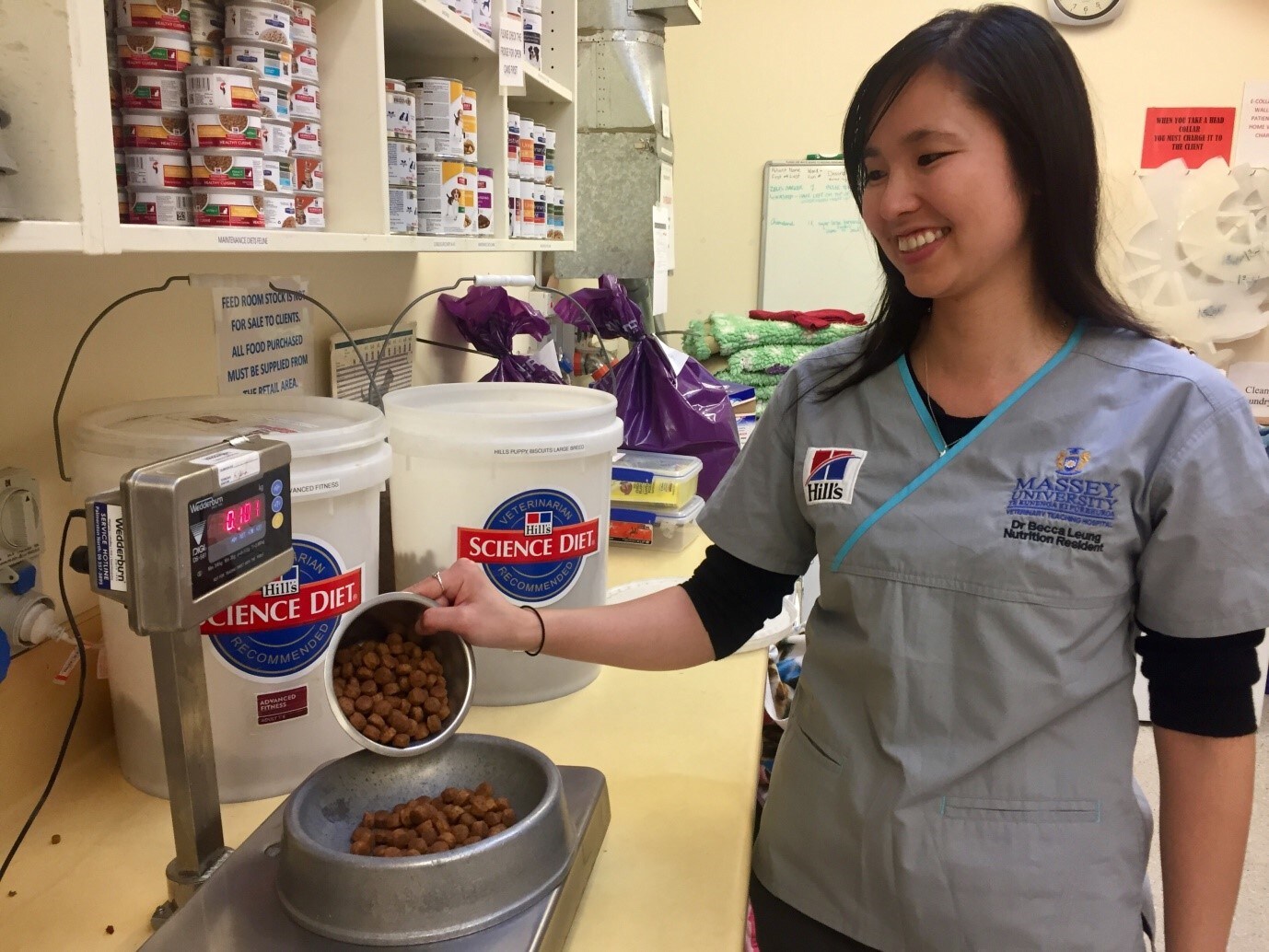7:30 am: The Monday morning begins as many do with a gathering of clinician around the sizable patient white board hanging in the main hallway of the hospital. We come from all services: medicine, surgery, ECC, oncology, community practice, and nutrition, and here we congregate to listen to the intern give her report of how each patient faired overnight. As part of the clinical nutrition residency, my fellow resident-mate and I oversee the nutrition for every in-hospital patient, along with some out-patients as well. We ensure that each dog/cat/rabbit/guinea pig has an appropriate feeding plan, and monitor for hyporexia, anorexia and when nutrition intervention or dietary modification is needed.
As the overnight intern goes down her list of each patient, the words “losing weight” and “still not eating” peak my attention. She is talking about one of the feline patients in hospital who was recovering from a right femoral fracture and left tarsal luxation after being hit by a car. The cat was initially stabilised at their referring veterinarian for two days, and did not eat during this time. On admission to our hospital, the cat did not eat his dinner that night and then was purposefully fasted for surgery. On the second day, the cat again did not eat after recovery from anaesthesia. Now, today is the fourth full day (in total) of anorexia, and something needed to be done; any patient that has not eaten for three days or longer (including days before admission) should be considered a candidate for nutritional intervention (i.e. syringe feeding or to place a feeding tube).
Cats, especially anxious cats, can be notoriously difficult to entice to eat in hospital. Neophobia is commonplace. Therefore it is important to get a thorough dietary history from every patient, not only as a part of the fifth vital assessment, but to also provide guidance as to what might be the more favoured option from your hospital pantry: dry food, canned food, a certain brand, etc. In this case, the cat was fed a combination of supermarket dry and canned food at home. In the hospital, he had been offered a variety of dry and canned food to which he showed a little interest and would sniff, but would not eat.
A visit to the patient found him bright, alert, and sporting an Elizabethan collar. There is food left in the front corner of the cage from that morning’s offering, but it is untouched. A check of the patient finds no clinical signs that could illuminate the reason for the inappetance, such as nausea, pain, and/or anxiety. The cat looks quite bright and well, albeit his fur is a little unkempt. So I wonder whether a little extra care is all that he needs. I first move the food bowl from the front of the cage, where it may be too scary for nervous cats, and place it as far away as possible from the litter box. This can be difficult in smaller cages, but we try our best. I also remove the Elizabethan collar to allow our furry patient a little freedom and sit down next to the cage to guard the bandage site. Immediately after removing the collar, the cat takes a nice, long stretch, and rolls over for a nice ear and chin scratch. After this, he launches into groom himself. He looks so much happier to be without his cone and to be able to exhibit some natural behaviour. This time, when food is offered, he voluntarily begins to eat! Success! It was just a little TLC this guy needed. I made a note on his chart that he is willing to eat with the cone off, but to do so under supervision.


8:30 am: There are two patients with feeding tubes in hospital who have multiple meals scheduled throughout the day. I take a walk around the ICU and observe the feeding of these patients by the vet and vet tech students. A common misconception for feeding patients with nasoesophagel or oesophagostomy tubes is that elevating their head is sufficient to reduce regurgitation. However, it is actually the elevation of where the tube ends, namely the distal oesophagus, that is important. So ideally, dogs should be fed in a sitting position, and for cats, they can be fed laying in sternal recumbency in your lap with their heads facing forward. You can raise your knees or place a rolled towel under their thorax so that they are lying on a slope, with their distal oesophagus on an incline. The stroll around the ICU finds the students happy and feedings going well. All said, the morning bedside check of patients indicates that all the hospital patients are doing well. So far so good.

10am: I head to my office to start our referral cases for the day. We take internal and external nutrition referrals from around the world, which can range from providing commercial diet advice, to complex recipe formulation when there are no suitable commercial options, or the owner wants to home-prepare. This is a key part of the residency training, learning the science, and importantly the art, of recipe formulation.
While we focus on nutrition referrals for animals who are unwell, there is a growing interest in owners wanting to home-prepare diets for their healthy dogs and cats. We often get requests from veterinarians or owners seeking advice or wanting us to analyse other people’s recipes. Whilst there is no shortage of either recipes or information available on the internet, there is unfortunately far more unbalanced recipes and misinformation out there. In my four years of residency training, I have yet to find a nutritionally complete and balanced recipe that was not formulated by a board-certified veterinary nutritionist. This includes ones formulated by other veterinarians with an interest in nutrition, and from recipes modelled after a “prey diet” which contain liver, bones, added vitamins and taurine. Even those recipes are commonly deficient.
The consult today is for an ideally conditioned (body condition score 5/9), seven-year-old, male miniature schnauzer with a history of fasting hypertriglyceridemia, calcium oxalate urolithiasis and diabetes mellitus. The nutritional goals for this patient is complex, with a need to restrict dietary fat, moderate calcium, carbohydrate and protein intake, increase dietary moisture and fibre, and while avoiding feeding ingredients which contain oxalates. Although there are commercial options available to suit the needs of this dog, the owners prefer to home-prepare. So I create a skinless chicken breast, white rice, broccoli and cabbage recipe which meets the nutritional goals for this patient. I type a letter to the referring veterinarian with the recipe and an explanation of each goal and how we achieved it. One consult down, two more to go.
3pm: I finish formulating the recipes and writing the consult letters around 2:30pm. At 3pm, I head to the meeting room to have a clinical nutrition lecture with a group of final year veterinary students. This talk is case-based and runs through common scenarios they will likely face out in their first year of practice: a puppy with acute gastroenteritis, a dog losing weight, the obese patient, an owner feeding an unconventional diet, etc. It is sometimes surprising to the students how much nutrition plays into the management of many of the patients.

4-5pm: Late afternoon is best time to return to the clinic for afternoon patient checks to see if any new patients have been admitted, and whether any feeding plans need adjusting. This is also commonly the time when we know whether any patients have received feeding tubes and require specialised feeding plans.
There are a few new patients in the hospital, which already have feeding plans in place – the students are doing well! The patients with the feeding tubes have tolerated their meals, and one was even starting to eat a little on her own. A check on the cat from this morning finds him still happy as Larry and eating, which is so rewarding to see. All in all, everyone looks good!
6pm: Time to pack it up for the day. I should probably organise food for dinner, as we all know how important nutrition is!
 Blog by: Dr Becca Leung, BSc, BVSc
Blog by: Dr Becca Leung, BSc, BVSc
Veterinary Clinical Nutrition Resident, Massey University
Originally from Florida, Becca obtained a Bachelor of Animal Science from the University of Florida. Then, after a 6-month internship at Disney’s Animal Kingdom in their animal nutrition department, Becca found her passion for nutrition and its vital dual role in maintain health and treating disease. She attended Massey University in New Zealand for her veterinary degree and stayed on to do a combined clinical nutrition residency and PhD. Her thesis focuses on improving outcomes of recovering canine spinal patients through intermittent fasting and promoting ketogenesis.